
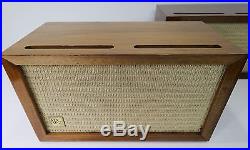


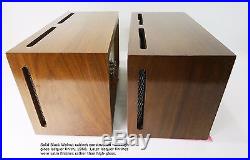
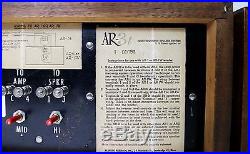

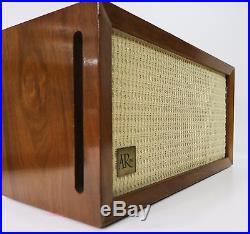



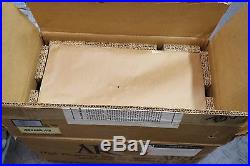
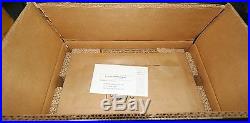

AR-3 t Pair (2). Serial Numbers: T 00058 and T 00061. These were manufactured in 1959, not 1960 as shown in images. 2-inch Mid-Range Dome and 1 Super-Tweeter. Dome Drivers and Crossover. Converts an AR-1 (Woofer only) or AR-1W to Equivalent of an AR-3. For use with AR-1 or AR-1W. General Product Description of the Acoustic Research AR-3st 1-inch Super Tweeter. The AR-3 t used the Acoustic Research AR-3 2-inch dome mid-range and the. 1-inch dome super-tweeter and. Was designed originally to add the AR-3 capability to an AR-1W or an AR-1 (woofer-only operation). It included a beautiful, solid-stock , lacquer-or-oil-finished cabinet with the AR-3-saran-type grill cloth material that would match the AR-1 grill, and it had famous solid-brass “AR” logo plate attached to the bottom-left corner (horizontal view). The system could be used in either a horizontal or vertical position. The AR-3 t included the standard AR-3 1,000 and 7,500 Hz crossover network, and included level controls for both drivers. The AR-3t is the high-frequency portion of the AR-3. To knowledgeable audiophiles and historians, the Acoustic Research AR-3 needs no detailed introduction. From its commercial introduction in the fall of 1958 at the New York High Fidelity Music Showand throughout the next decadethe AR-3 became known as one of the finest and most accurate loudspeakers commercially available at any price. Its design was the culmination of the work done on the patented acoustic-suspension AR-1 and the patented dome midrange and tweeter assemblies developed in ARs laboratories. This landmark design was based on extensive research and objective-test measurement techniques used by Acoustic Research. ARs measurement techniques, using their anechoic chambers and reverberant-test chambers, were easily repeatable by other testing labs, and AR pioneered in publishing the results of this testing. This was somewhat controversial at a time when most loudspeaker companies relied upon listening tests to develop loudspeakers, and generally kept their internal testing results proprietary. The result of ARs objective-design philosophy was a loudspeaker capable of high accuracy. The AR-3 was the first commercial loudspeaker to use direct-radiator, hemispherical dome midrange and tweeter drivers. These dome drivers, as well as the acoustic-suspension woofer system (first used on the 1954 AR-1), were covered under AR patents. The acoustic-suspension woofer and dome tweeter are commonplace and virtually universal in the speaker industry today. As a lasting tribute to this remarkable piece of history, an AR-3 is on permanent display in The Natural Museum of American History, Smithsonian Institution. When the AR-3 was introduced, it had no peer in terms of low-frequency extension, low distortion and extended, high-frequency acoustic-power response. It is still considered to be one of the finest loudspeakers ever designed. Its place in history was made secure during the early 1960s when Acoustic Research conducted dozens of public, live- vs. These bold, live concerts compared pre-recorded music on AR-3s to the Fine Arts Quartet, classical-guitarist Gustavo Lopez and a restored Seaburg Nickelodeon. In virtually every demonstration, listeners were unable to detect the switchovers between the live musicians and the reproducing AR-3 loudspeakers. Because of the AR-3s remarkable critical acclaim and ground-breaking innovation during this period, it quickly became a classic loudspeaker design, and has become a highly-collectible audio artifact. Audio legend Julian Hirsch said of the AR-3 in his 1960 High Fidelity magazine review: The sounds produced by this speaker are probably more true to the original program than those of any other commercially manufactured speaker system we have heard. The leading consumer organization stated that the AR-3 had the deepest bass ever measured in their laboratories. AR-3 t Performance and Physical Description. The AR-3t utilizes the AR-3 midrange driver, which uses a 2-inch phenolic-dome (hemispherical) diap. Gm with a self-supporting, 2-inch aluminum voice coil and 9.3 lb. The super tweeter uses a 1-3/8-inch phenolic-dome diap. Gm of the same design, using a 3.1 lb. Alnico-5 magnet assembly, and the drivers have LC crossover frequencies of 1000 Hz and 7,500 Hz. The AR-3t’s impedance is 4 ohms, and it is designed to be used with the AR-1 or AR-1W woofer system, which matches in crossover performance and sensitivity. Drivers measured individually in AR’s anechoic chamber. High-frequency dispersion, measured 45° off-axis in any direction is -3 dB at 10 kHz and -7 dB at 15 kHz. The dome mid-range and super tweeter have very wide dispersion in any direction when measured off-axis, and the system has exceptionally wide and uniform acoustic-power response. Uniform polar response measurement of this system was greater than 90° at 8 kHz in any direction, even with the grill molding in place. Overall Description covered by. Reproduction or copying of any of this material without the express permission of the writer is unlawful and prohibited. These AR-3 t s , Serial Number T 00058 and T 00061, are very early and quite rare 1960 early-production units and have had limited use over time with very few hours and are in excellent overall condition throughout. The cabinets are a high-gloss lacquered walnut and have a few small marks or scratches. All driver work properly, but the level controls have oxidized and will need to be “turned” back and forth several time to find a spot without oxidation. Please do not request the Reserve Price amount if applicable. Average transit time from the East Coast to the West Coast is one week. The item “Acoustic Research AR AR-3t Mid-Range and Super-Tweeter, Vintage, Pair, EC Wal” is in sale since Sunday, November 22, 2015. This item is in the category “Consumer Electronics\Vintage Electronics\Vintage Audio & Video\Vintage Speakers”. The seller is “acoustic-research-inc” and is located in High Point, North Carolina. This item can be shipped worldwide.
- Brand: Acoustic Research, Inc. (“AR”)
- Model: AR-3t Mid-Range and Super-Tweeter Unit
- Country/Region of Manufacture: United States
